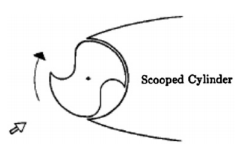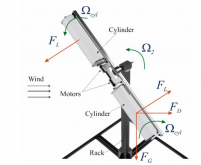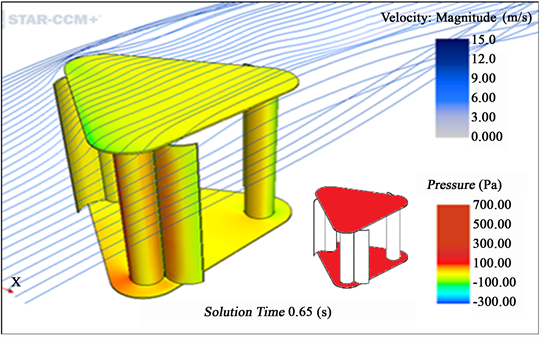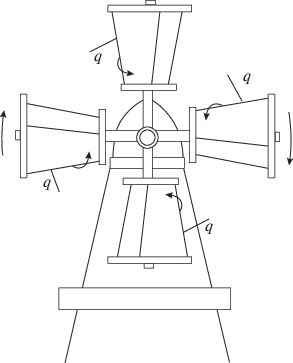This
study tested a variety of 1 meter long rotor shapes:
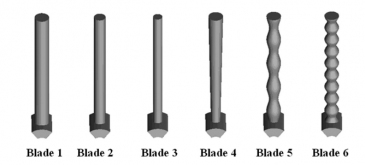
Blade 1 - .5m diameter, b = length-to-diameter = 9
Blade 2 - .4m diamter, b = 11.3
Blade 3 - .32 m diameter, b = 14.1
Blade 4 - .32, .4, .5m diameters,
Blade 5 - .32 m to .5m, wavelenght of 1 m
Blade 6 - .32 m to .5m, wavelenght of .5 m
Jackpot! This study recognizes that the net power is what's important. They were also kind enough to post the energy consumption of the rational energy for blade 3. Unsure, but again looks like the energy required was independent of shape.

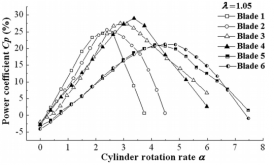
As predicted in the post above, blade 4 (a conical frustum) produced the highest power.
In regards to starting torque:
Although the starting torque of the turbine with blade 4 is initially low and very close to that of the turbine with blade 3, the torque of the turbine with blade 4 can remain relatively high compared to that of the turbine with other blades at high tip speed ratios.
Conclusions
- For the Magnus turbine equipped with straight circular cylinders, it was apparent that the power coefficient Cp of the turbine is highly dependent on the length-to-diameter ratio b of the cylinder. At a fixed cylinder rotation rate α, larger b results in a wider operating range of tip speed ratios λ and higher Cp. At the same λ, the turbine with cylinder having larger b can also achieve higher Cpmax at high α, in spite of the fact that its Cp can be relatively low at small α.
- When operating at low α and λ, the Magnus turbine whose blades have a shape as the frustum of a cone has a lower Cp compared to that of the turbine with circular cylinder. However, its maximum efficiency Cpmax can be markedly promoted if the turbine and the conical frustum run at relatively high values of λ and α.
- According to the three-dimensional numerical simulation of the flow past a wavy cylinder, the mean lift coefficient of a wavy cylinder can only reach a value close to that of a straight cylinder if the rotation speed of the wavy cylinder is twice as fast as that of the straight cylinder. In order to enable the Magnus turbine using wavy cylinder to generate a high torque, the wavy cylinder has to be rotated at a rather fast speed, which will accordingly consume a lot of energy and result in a low Cp of the Magnus turbine.
- Controlling the rotational speed of the cylinder can be an effective method for regulating the power produced and axial thrust of a Magnus wind turbine.
α Cylinder rotation rate
b Length-to-diameter ratio of the cylinder
λ Tip speed ratio of the Magnus turbine
What's the deal with high tip speed?
I don't get it...torque is important. If anything the tip speed should be as minimal as possible to decrease drag. Shouldn't the highest force be when it's not moving at all? This doesn't make sense to me, chances are good I've got something wrong. Could this be more of an artifact of how the measurements were made?
λ = R Ω1 / Ω∞, where R is the radius of the turbine, Ω1 is the rotational speed of the tip of the blade, and Ω∞ is the wind velocity
α = r Ω2 / Ω∞, where r is the radius of the cylinder and Ω2 is the angular speed
They're seeing best power at a tip speed of ~1.75 for blade 4. You can see in the energy plot it says the turbine speed is 90 RPM, seems too fast to me.
Update: What the Heck?
Realized Blade 1 was the same diameter as the tip of blade 4, so via the math blade 1 should have had the highest power. Possibly this is the impact from the vortices as these don't have end-plates?




